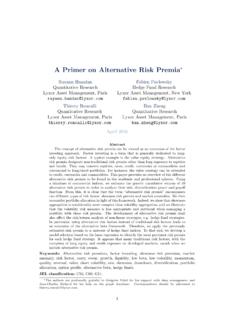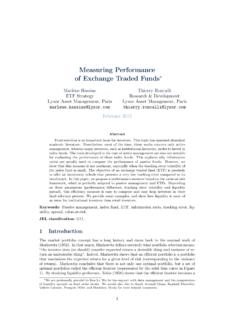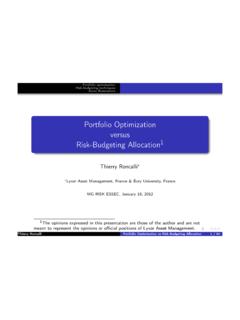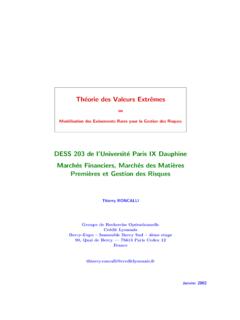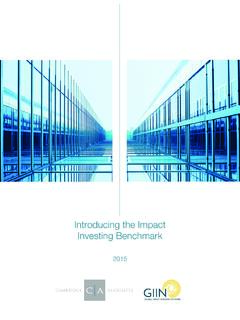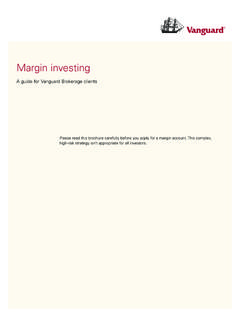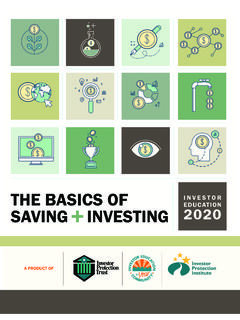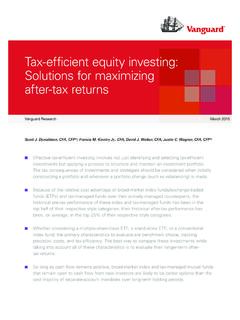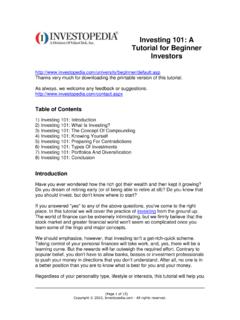Transcription of Facts and Fantasies About Factor Investing - Thierry Roncalli
1 Facts and Fantasies About Factor InvestingZ elia CazaletQuantitative ResearchLyxor Asset Management, RoncalliQuantitative ResearchLyxor Asset Management, 2014 AbstractThe capital asset pricing model (CAPM) developed by Sharpe (1964) is the startingpoint for the arbitrage pricing theory (APT). It uses a single risk Factor to model therisk premium of an asset class. However, the CAPM has been the subject of impor-tant research, which has highlighted numerous empirical contradictions. Based on theAPT theory proposed by Ross (1976), Fama and French (1992) and Carhart (1997)introduce other common factors models to capture new risk premia. For instance, theyconsequently define equity risk factors , such as market, value, size and momentum. Inrecent years, a new framework based on this literature has emerged to define strategicasset allocation.
2 Similarly, index providers and asset managers now offer the oppor-tunity to invest in these risk factors through Factor indexes and mutual funds. Thesetwo approaches led to a new paradigm called Factor Investing (Ang, 2014). Factorinvesting seems to solve some of the portfolio management issues that emerged in thepast, in particular for long-term investors. However, some questions arise, especiallywith the number of risk factors growing over the last few years (Cochrane, 2011). Whatis a risk Factor ? Are all risk factors well-rewarded? What is their level of stability androbustness? How should we allocate between them? The main purpose of this paperis to understand and analyze the Factor Investing approach in order to answer : Factor Investing , risk premium, CAPM, risk Factor model, anomaly, size, value,momentum, volatility, idiosyncratic risk, liquidity, carry, quality, mutual funds, hedge funds,alternative beta, strategic asset classification:C50, C60, IntroductionRisk Factor Investing has grown in popularity in recent years and has become an importantconcept within investment portfolios.
3 It is best defined as an attempt to capture systematicrisk premia. In the CAPM theory, there is a single market risk premium, which can beobtained by Investing in market-capitalization indexes. But since CAPM was introduced,academic researchers have put forward convincing evidence that there are other systematicsources of return. These alternative risk premia include, for example, risk factors related toa stock s size or valuation. The idea of Factor Investing is then to enlarge the asset universeby adding these risk factors to the existing market risk factors , which are simply asset classessuch as equities and bonds. The goal is then to generate more returns in the long run. Asexplained by Ang (2014), it is precisely because factors episodically lose money in bad1 Facts and Fantasies About Factor Investingtimes that there is a long-run reward for being exposed to Factor risk.
4 Factor premiums arerewards for investors enduring losses during bad times. One of the issues with Factor Investing is to define which factors really matter. For along time, the standard model was the four Factor model of Carhart (1997). Based on themodel developed by Fama and French (1992), which is based on the size and value factors ,Carhart (1997) proposed to add the momentum Factor found by Jegadeesh and Titman(1993). More recently, other factors have emerged such as the volatility, low beta, qualityor liquidity factors , to name just a few. However, the existence of more and more factorsdoes not help. In fact , Cochrane (2011) has recently referred to a zoo of new factors .For instance, Harveyet al.(2014) counted over 300 in various academic papers, and theirnumber has been increasing exponentially (see Figure 1).
5 In such situations, the investormay be lost in front of the Factor 1: factors and publications (Harveyet al., 2014)In this context, the pertinence of risk factors is an open issue. In fact , the literature onrisk factors generally focuses on the cross-section of expected returns . The underlying ideais to discover independent patterns that can help to explain the dispersion of asset that, academics use a standard method based on the pioneer research of Chanet al.(1991) and Fama and French (1993). The procedure consists in forming sorted portfoliosbased on some characteristics and to test whether portfolio returns are sensitive to a givenpattern. One of the issues is the alpha puzzle of the cross-section. Indeed, if one factormodel is valid, this implies that portfolio returns adjusted by risk factors have no alpha.
6 Forinstance, if the Carhart model is appropriate, this implies that there is alpha in diversifiedportfolios if we only use the Fama-French risk factors . If we now consider that the relevantmodel is a five Factor model composed of the previous Carhart risk factors and the lowvolatility anomaly, this implies that alpha is present in diversified portfolios if we considerthe Carhart risk factors . And the story is repeating itself with the discovery of new factorslike quality or liquidity. Here is the mystery. How can alpha always come back?2 Facts and Fantasies About Factor InvestingAnother issue with factors concerns the nature of these patterns. Are they risk factors oranomalies? The notion of risk Factor refers to a natural risk premium, which rewards the risktaken by investors.
7 For instance, we can think that the size Factor is a risk Factor , becausesmall stocks are more risky than large stocks. But we can also think that the momentumfactor is more an anomaly. In this case, the abnormal return posted by this Factor is nota risk premium, but can only be explained by investment behaviors. The question of thevalue Factor is more complicated. On the one hand, some portfolio managers consider thatthe goal of value strategies is to build aggressive portfolio by selecting distressed stocks. Forinstance, this point of view is supported by Fama and French (1998). On the other hand,other portfolio managers consider that the goal of value strategies is to build defensiveportfolio by selecting quality stocks (Piotroski, 2000). The value Factor encompasses twodifferent realities: one is clearly a risk premium and the other is clearly an anomaly.
8 Andeach of these realities may be illustrated by the behaviorial difference of the value strategyduring the 2008 financial crisis and the dot-com bubble in the last few years, Factor Investing has rapidly attracted the asset managers andalso large institutional investors. It is now a hot topic in the investment industry. However,most of the time it is presented as a very simple investment approach that gives superiorresults compared to traditional approaches, such as strategic asset allocation based on assetclasses. But as noted by Ang (2014), each Factor defines a different set of bad times . Thismeans that Factor returns are time-varying and factors may highly underperform for a longtime. In this context, a constant mix allocation based on risk factors makes sense only forlong-term investors and the question of the horizon time is decisive.
9 Are investors readyto wait ten years if small caps or value stocks underperform large caps or growth stocks?The answer has to be no. This is why Factor Investing raises the question of multi-factorallocation. It is true that diversifying across factors is a way to diversify across all these badtimes. Unfortunately, these bad times are not always is another aspect of Factor Investing . Until recently, these factors wereavailable by Investing in mutual funds. Now, both active management and passive man-agement propose investment vehicles and give access to these factors . The development offactor indexes will certainly help to rationalize the asset management industry. However, onequestion remains. How to transform these academic risk factors into investible portfolios?
10 This implies studying the capacity, turnover and transaction costs of these Factor portfoliosand also the impact of the constraints on such investments such as long-only the marketing operation where factors are everywhere and everything is a Factor ,it is tempting to reject this approach by saying that it is just the latest fashion. However, Factor Investing is a necessary tool to understand where the performance comes from anda powerful concept to challenge and enhance long-term investment strategies. Thus, factorbenchmarks proposed by Ang (2014) are a new step to help long-term investors to assessthe performance of their investments. However, there is a gap between ex-post analysis (orperformance measurement) and ex-ante capital budgeting (or portfolio allocation). The goalof this paper is then to provide an overview of the two sides of Factor Investing (risk factorsand long-run allocation) and to show that it is not as simple as it is often presented.
